Optimizing P3HT/PCBM-Based Organic Photodetector Performance: Insights from SCAPS 1D Simulation Studies
Abstract
1. Introduction
2. Device Structure and Numerical Simulations
3. Results and Discussion
3.1. Optimization of the Thickness of the P3HT Layer
3.2. Optimization of the PCBM Layer Thickness
3.3. Effect of Varying P3HT Donors on Photodetector Performance
3.4. Effect of the Metal Electrode Work Function
3.5. Effect of the (IDL) Interface Defect Layer
3.6. Optimized Device
| Ref. | Device Structure | Voc (V) | Jsc (mA/cm²) | FF (%) | PCE (%) |
|---|---|---|---|---|---|
| [45] | P3HT/PCBM | 0.72 | 19 | 63 | 8.62 |
| [46] | P3HT:PCBM blend with embedded SiO2@Ag@SiO2 nanoparticles | 0.60 | 16.31 | 76.6 | 7.61 |
| [47] | ITO/PEDOT:PSS/P3HT:PC60BM/Al | 0.66 | 12.01 | 59 | 4.65 |
| [48] | /ITO/PEDOT:PSS/P3HT/P3HT:PCBM/PFN:BR/Al | 0.76 | 22.6 | 82.33 | 14.32 |
| This work | FTO/P3HT/PCBM/Al | 1.91 | 23.41 | 91.10 | 40.79 |
4. Conclusions
Author Contributions
Funding
Data Availability Statement
Acknowledgments
Conflicts of Interest
References
- Ren, H.; Chen, J.D.; Li, Y.Q.; Tang, J.X. Recent Progress in Organic Photodetectors and Their Applications. Adv. Sci. 2021, 8, 2002418. [Google Scholar] [CrossRef] [PubMed]
- Ma, X.; Janssen, R.A.; Gelinck, G.H. Trap-Assisted Charge Generation and Recombination in State-of-the-Art Organic Photodetectors. Adv. Mater. Technol. 2023, 8, 2300234. [Google Scholar] [CrossRef]
- Huang, Y.; Yang, J.; Zhao, D.; Zhang, Y.; Liu, Z.; Liang, F.; Chen, P. Role of Vacancy Defects in Reducing the Responsivity of AlGaN Schottky Barrier Ultraviolet Detectors. Nanomaterials 2022, 12, 3148. [Google Scholar] [CrossRef] [PubMed]
- Jiao, J.; Zhang, Y.; Shi, L.; Li, G.; Ji, T.; Wang, W.; Wen, R.; Hao, Y.; Wang, K.; Zhu, F.; et al. High Responsivity of Narrowband Photomultiplication Organic Photodetector via Interfacial Modification. Adv. Opt. Mater. 2023, 11, 2203132. [Google Scholar] [CrossRef]
- Huang, Z.; Xu, S.; Zhang, Z.; Wang, Z.; Hu, Y. Laser Shock Introduced Strain and Plasmonic Nanogap Engineered Large-Scale High-Performance Monolayer 2D Material Optoelectronic Devices. Adv. Mater. Technol. 2023, 8, 2300557. [Google Scholar] [CrossRef]
- Anabestani, H.; Nabavi, S.; Bhadra, S. Advances in Flexible Organic Photodetectors: Materials and Applications. Nanomaterials 2022, 12, 3775. [Google Scholar] [CrossRef] [PubMed]
- Jacoutot, P.; Scaccabarozzi, A.D.; Nodari, D.; Panidi, J.; Qiao, Z.; Schiza, A.; Nega, A.D.; Dimitrakopoulou-Strauss, A.; Gregoriou, V.G.; Heeney, M.; et al. Enhanced Sub-1 eV Detection in Organic Photodetectors through Tuning Polymer Energetics and Microstructure. Sci. Adv. 2023, 9, eadh2694. [Google Scholar] [CrossRef] [PubMed]
- Qiao, J.W.; Cui, F.Z.; Feng, L.; Lu, P.; Yin, H.; Hao, X.T. Efficient Ultrathin Self-Powered Organic Photodetector with Reduced Exciton Binding Energy and Auxiliary Föster Resonance Energy Transfer Processes. Adv. Funct. Mater. 2023, 33, 2301433. [Google Scholar] [CrossRef]
- Wang, F.; Zhang, T.; Xie, R.; Wang, Z.; Hu, W. How to Characterize Figures of Merit of Two-Dimensional Photodetectors. Nat. Commun. 2023, 14, 2224. [Google Scholar] [CrossRef]
- Altıner, B.; Erol, B.; Delibaşı, A. Optimal Actuator Placement in Adaptive Optics Systems. J. Vib. Control 2022, 28, 3397–3410. [Google Scholar] [CrossRef]
- Erol, B.; Altıner, İ.B.; Delibaşı, A. Genişletilmiş Veri Kümesi Ile Uyarlamalı Optik Sistemlerin Modelinin Kestirimi. Gazi Üniversitesi Mühendislik Mimarlık Fakültesi Dergisi 2024, 39, 1825–1836. [Google Scholar] [CrossRef]
- Siddik, A.B.; Georgitzikis, E.; Hermans, Y.; Kang, J.; Kim, J.H.; Pejovic, V.; Lieberman, I.; Malinowski, P.E.; Kadashchuk, A.; Genoe, J.; et al. Interface-Engineered Organic Near-Infrared Photodetector for Imaging Applications. ACS Appl. Mater. Interfaces 2023, 15, 30534–30542. [Google Scholar] [CrossRef] [PubMed]
- Liu, M.; Miao, J.; Wang, J.; Zhao, Z.; Yang, K.; Zhang, X.; Peng, H.; Zhang, F. Broadband Organic Photodetectors Exhibiting Photomultiplication with a Narrow Bandgap Non-Fullerene Acceptor as an Electron Trap. J. Mater. Chem. C 2020, 8, 9854–9860. [Google Scholar] [CrossRef]
- Yan, X.; Wang, X.; Gao, S.; Qiao, W. High-Performance Organic Photodetectors Using SnO2 as Interfacial Layer with Optimal Thickness. Phys. Status Solidi A 2023, 220, 2200667. [Google Scholar] [CrossRef]
- Zhai, A.; Zhao, C.; Pan, D.; Zhu, S.; Wang, W.; Ji, T.; Li, G.; Wen, R.; Zhang, Y.; Hao, Y.; et al. Organic Photodetectors with Extended Spectral Response Range Assisted by Plasmonic Hot-Electron Injection. Nanomaterials 2022, 12, 3084. [Google Scholar] [CrossRef] [PubMed]
- Salem, M.S.; Shaker, A.; Al-Bagawia, A.H.; Aleid, G.M.; Othman, M.S.; Alshammari, M.T.; Fedawy, M. Narrowband Near-Infrared Perovskite/Organic Photodetector: TCAD Numerical Simulation. Crystals 2022, 12, 1033. [Google Scholar] [CrossRef]
- Korte, D.; Pavlica, E.; Klančar, D.; Bratina, G.; Pawlak, M.; Gondek, E.; Song, P.; Liu, J.; Derkowska-Zielinska, B. Influence of P3HT:PCBM Ratio on Thermal and Transport Properties of Bulk Heterojunction Solar Cells. Materials 2023, 16, 617. [Google Scholar] [CrossRef] [PubMed]
- Husen, M.J.; Aga, F.G.; Dibaba, S.T. Theoretical Performance Analysis of Inverted P3HT: PCBM Based Bulk Hetero-Junction Organic Solar Cells through Simulation. Adv. Mater. Sci. Eng. 2023, 2023, 4204298. [Google Scholar] [CrossRef]
- Sreejith, S.; Sivasankari, B. A Review on P3HT:PCBM Material Based Organic Solar Cells. In Proceedings of the 2022 IEEE International Conference on Nanoelectronics, Nanophotonics, Nanomaterials, Nanobioscience & Nanotechnology (5NANO), Kottayam, India, 28–29 April 2022; Available online: https://ieeexplore.ieee.org/document/9828992 (accessed on 5 June 2024).
- Xian, K.; Liu, Y.; Liu, J.; Yu, J.; Xing, Y.; Peng, Z.; Zhou, K.; Gao, M.; Zhao, W.; Lu, G.; et al. Delicate Crystallinity Control Enables High-Efficiency P3HT Organic Photovoltaic Cells. J. Mater. Chem. A 2022, 10, 3418–3429. [Google Scholar] [CrossRef]
- Sen, S.; Islam, R. Effect of Different Layers on the Performance of P3HT:PCBM-Based Organic Solar Cell. Braz. J. Phys. 2021, 51, 1661–1669. [Google Scholar] [CrossRef]
- Ghosekar, I.C.; Patil, G.C. Review on Performance Analysis of P3HT:PCBM-Based Bulk Heterojunction Organic Solar Cells. Semicond. Sci. Technol. 2021, 36, 045005. [Google Scholar] [CrossRef]
- Baghel, R.; Verma, M.L.; Kumar, H.; Verma, S. Structural, Electronic and Optical Properties of (P3HT)n in Context of Organic Solar Cells: DFT Based Approach. In Proceedings of the 2021 International Conference on Advances in Electrical, Computing, Communication and Sustainable Technologies (ICAECT), Bhilai, India, 19–20 February 2021; Available online: https://ieeexplore.ieee.org/document/9392484 (accessed on 5 June 2024).
- Rana, D.; Jovanov, V.; Wagner, V.; Materny, A.; Donfack, P. Insights into Ultrafast Charge-Pair Dynamics in P3HT:PCBM Devices under the Influence of Static Electric Fields. RSC Adv. 2020, 10, 42754–42764. [Google Scholar] [CrossRef] [PubMed]
- Naning, F.H.; Malik, S.A.; Hanafi, H.F. Isotherm Behaviour of P3OT, P3HT and PCBM Langmuir Layer on Ionic Subphase. J. Adv. Res. Appl. Sci. Eng. Technol. 2023, 29, 168–174. [Google Scholar]
- Darwis, D. Formation and Characterization of Mini-Emulsion P3HT PCBM Nanoparticles. Nat. Sci. J. Sci. Technol. 2020, 9, 45–48. [Google Scholar] [CrossRef]
- Sharma, H.; Verma, V.K.; Singh, R.C.; Singh, P.K.; Basak, A. Numerical Analysis of High-Efficiency CH3NH3PbI3 Perovskite Solar Cell with PEDOT:PSS Hole Transport Material Using SCAPS 1D Simulator. J. Electron. Mater. 2023, 52, 4338–4350. [Google Scholar] [CrossRef]
- Srivastava, P.; Sadanand; Rai, S.; Lohia, P.; Dwivedi, D.K.; Qasem, H.; Umar, A.; Akbar, S.; Algadi, H.; Baskoutas, S. Theoretical Study of Perovskite Solar Cell for Enhancement of Device Performance Using SCAPS-1D. Phys. Scr. 2022, 97, 125004. [Google Scholar] [CrossRef]
- Uddin, M.N.; Afrin, P. Comparative Performance Analysis of Poly (3-Hexylthiophene-2, 5-Dial) and [6,6]-Phenyl-C61 Butyric Acid Methyl Ester-Based Organic Solar Cells in Bulk-Heterojunction and Bilayer Structure Using SCAPS. Optik 2024, 302, 171691. [Google Scholar] [CrossRef]
- Hima, A.; Le Khouimes, A.K.; Rezzoug, A.; Yahkem, M.B.; Khechekhouche, A.; Kemerchou, I. Simulation and Optimization of CH3NH3PbI3 Based Inverted Planar Heterojunction Solar Cell Using SCAPS Software. Int. J. Energetica 2019, 4, 56–59. [Google Scholar] [CrossRef]
- Zhang, N.; Xu, Z.; Tang, Q.; Hu, G.; Liu, D.; Wang, X.; Huang, J.; Zhang, Q.; Xu, X.; Hu, Y.; et al. Thickness-Ratio-Dependent Performances of Broadband Organic Photodiodes Based on a Tin Phthalocyanine/PTCDA Heterojunction. Opt. Lett. 2023, 48, 3579–3582. [Google Scholar] [CrossRef]
- Sulaman, M.; Yang, S.; Imran, A.; Zhang, Z.; Bukhtiar, A.; Ge, Z.; Song, Y.; Sun, F.; Jiang, Y.; Tang, L.; et al. Two Bulk-Heterojunctions Made of Blended Hybrid Nanocomposites for High-Performance Broadband, Self-Driven Photodetectors. ACS Appl. Mater. Interfaces 2023, 15, 25671–25683. [Google Scholar] [CrossRef]
- Tedde, S.F.; Kern, J.; Sterzl, T.; Fürst, J.; Lugli, P.; Hayden, O. Fully Spray Coated Organic Photodiodes. Nano Lett. 2009, 9, 980–983. [Google Scholar] [CrossRef] [PubMed]
- Zou, W.; Han, C.; Zhang, X.; Qiao, J.; Yu, J.; Xu, H.; Gao, H.; Sun, Y.; Kan, Y.; Hao, X.; et al. A Bithiazole-Substituted Donor for High-Efficiency Thick Ternary Organic Solar Cells via Regulation of Crystallinity and Miscibility. Adv. Energy Mater. 2023, 13, 2300784. [Google Scholar] [CrossRef]
- Chen, X.; Zhao, Z.; Jia, X.; Yu, Y.; Fang, Y.; Zhu, M.; Weng, Z.; Lei, W.; Shafe, S.B.; Mohtar, M.N. Localized Surface Plasmon Enhanced Carbon Dots Based Solar-Blind Ultraviolet Photodetectors by Al Nanoparticles. JNP 2023, 17, 026013. [Google Scholar] [CrossRef]
- Lv, Y.; Liu, J.; Zhang, Z.; Zhang, W.; Wang, A.; Tian, F. High-Performance Ultraviolet Photodetector Based on Sn-Doped CuO@ZnO Nanorod Arrays Composites. Ferroelectrics 2023, 610, 41–51. [Google Scholar] [CrossRef]
- Yang, Y.; Shi, Z.; Zhang, S.; Ma, X.; Bai, J.; Fan, D.; Zang, H.; Sun, X.; Li, D. Nonradiative Dynamics Induced by Vacancies in Wide-Gap III-Nitrides: Ab Initio Time-Domain Analysis. J. Phys. Chem. Lett. 2023, 14, 6719–6725. [Google Scholar] [CrossRef]
- Zheng, J.; He, X.; Zhang, Y.; Lyu, B.; Kim, J.; Li, S.; Lu, X.; Su, H.; Choy, W.C.H. A Bottom-up Understanding of the Ligand-Dominated Formation of Metallic Nanoparticle Electrodes with High Broadband Reflectance for Enabling Fully Solution-Processed Large-Area Organic Solar Cells. Energy Environ. Sci. 2023, 16, 3770–3780. [Google Scholar] [CrossRef]
- Kim, J.; Oh, H.; Kim, J.; Lee, J.-S. Effects of Work-Function Variation on Analog Figures-of-Merits of Inversion-Mode and Junctionless Nanowire Transistors. In Proceedings of the 2016 IEEE 16th International Conference on Nanotechnology (IEEE-NANO), Sendai, Japan, 22–25 August 2016; pp. 944–946. [Google Scholar]
- Zou, Y.; Zeng, Y.; Tan, P.; Zhao, X.; Zhou, X.; Hou, X.; Zhang, Z.; Ding, M.; Yu, S.; Huang, H.; et al. Alleviating the Responsivity-Speed Dilemma of Photodetectors via Opposite Photogating Engineering with an Auxiliary Light Source beyond the Chip. In Proceedings of the 2022 International Electron Devices Meeting (IEDM), San Francisco, CA, USA, 3 December 2022; p. 19.5.1–19.5.4. [Google Scholar]
- Fragasse, R.; Tantawy, R.; Smith, S.; Ay, S.; Khalil, W. An Open-Circuit Voltage Pixel for Low-Light Visible Imaging in a Standard CMOS Process. In Proceedings of the 2022 17th Conference on Ph.D Research in Microelectronics and Electronics (PRIME), Villasimius, Italy, 12 June 2022; pp. 289–292. [Google Scholar]
- Specht, T.R.; Duran, J.M.; Taghipour, Z.; Fragasse, R.; Tantawy, R.; Ronningen, T.J.; Ariyawansa, G.; Reyner, C.; Smith, D.S.; Fuller, E.; et al. Open-Circuit Voltage Photodetector Architecture for Infrared Imagers. Appl. Phys. Lett. 2020, 117, 163503. [Google Scholar] [CrossRef]
- Kielar, M.; Hamid, T.; Wiemer, M.; Windels, F.; Hirsch, L.; Sah, P.; Pandey, A.K. Light Detection in Open-Circuit Voltage Mode of Organic Photodetectors. Adv. Funct. Mater. 2020, 30, 1907964. [Google Scholar] [CrossRef]
- Open Circuit Voltage Photodetector (VocP) Infrared Imager. Available online: https://apps.dtic.mil/sti/citations/AD1092512 (accessed on 7 June 2024).
- Omer, B.M.; Khogali, A.; Pivrikas, A. AMPS-1D Modeling of P3HT/PCBM Bulk-Heterojunction Solar Cell. In Proceedings of the 2011 37th IEEE Photovoltaic Specialists Conference, Seattle, WA, USA, 19–24 June 2011; pp. 000734–000743. [Google Scholar]
- Omrani, M.; Fallah, H.; Choy, K.-L.; Abdi-Jalebi, M. Impact of Hybrid Plasmonic Nanoparticles on the Charge Carrier Mobility of P3HT:PCBM Polymer Solar Cells. Sci. Rep. 2021, 11, 19774. [Google Scholar] [CrossRef]
- Shaban, M.; Benghanem, M.; Almohammedi, A.; Rabia, M. Optimization of the Active Layer P3HT:PCBM for Organic Solar Cell. Coatings 2021, 11, 863. [Google Scholar] [CrossRef]
- Mir, A.M.; Bashir, F.; Khanday, F.A.; Zahoor, F.; Hanif, M.; May, Z. Design and Optimization of High Performance P3HT: PCBM Polymer Solar Cell Using P3HT Buffer Layer. IEEE Access 2024, 12, 10961–10969. [Google Scholar] [CrossRef]
- Chetia, A.; Saikia, D.; Sahu, S. Design and Optimization of the Performance of CsPbI3 Based Vertical Photodetector Using SCAPS Simulation. Optik 2022, 269, 169804. [Google Scholar] [CrossRef]
- Yang, D.; Ma, D. Development of Organic Semiconductor Photodetectors: From Mechanism to Applications. Adv. Opt. Mater. 2019, 7, 1800522. [Google Scholar] [CrossRef]
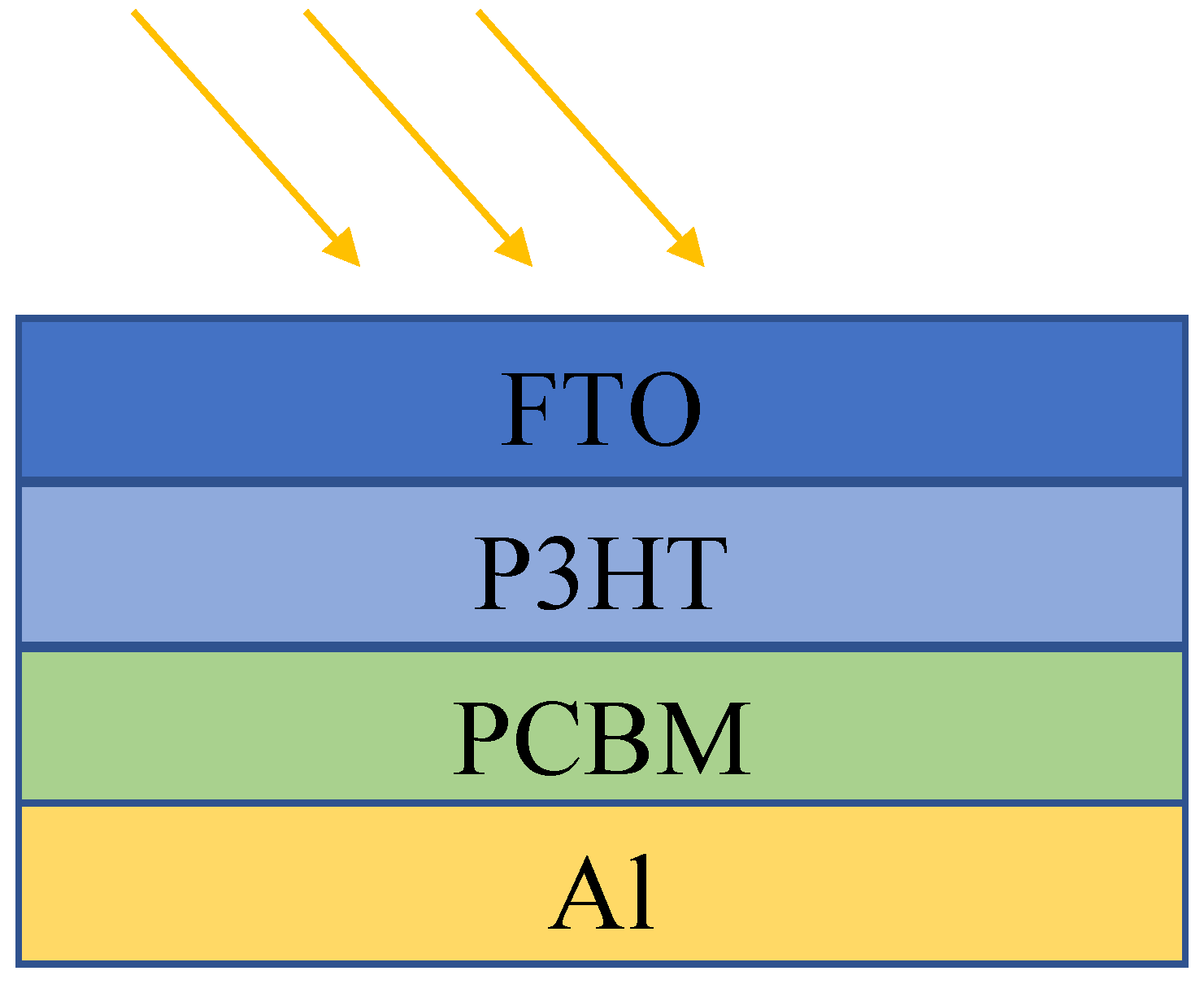
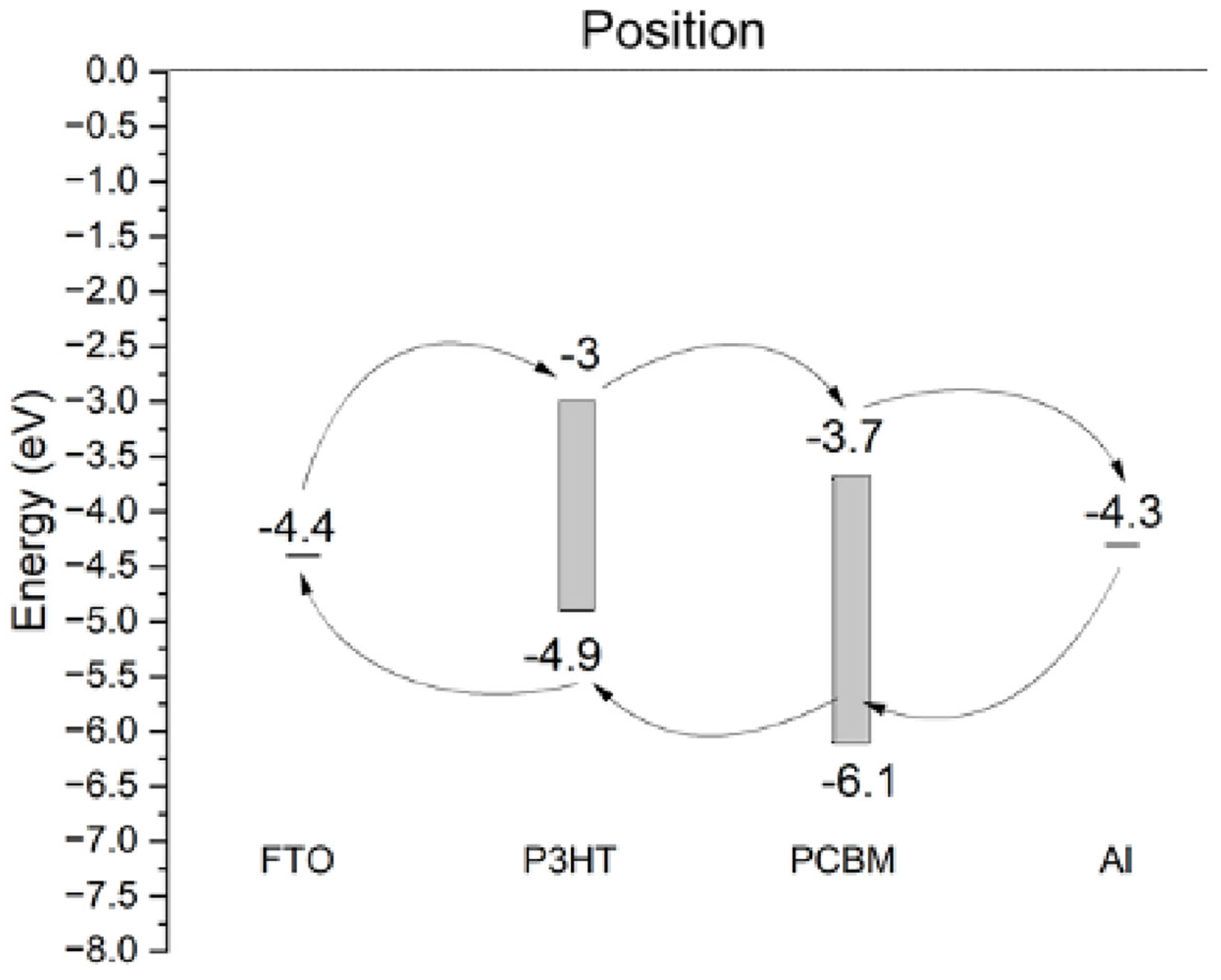

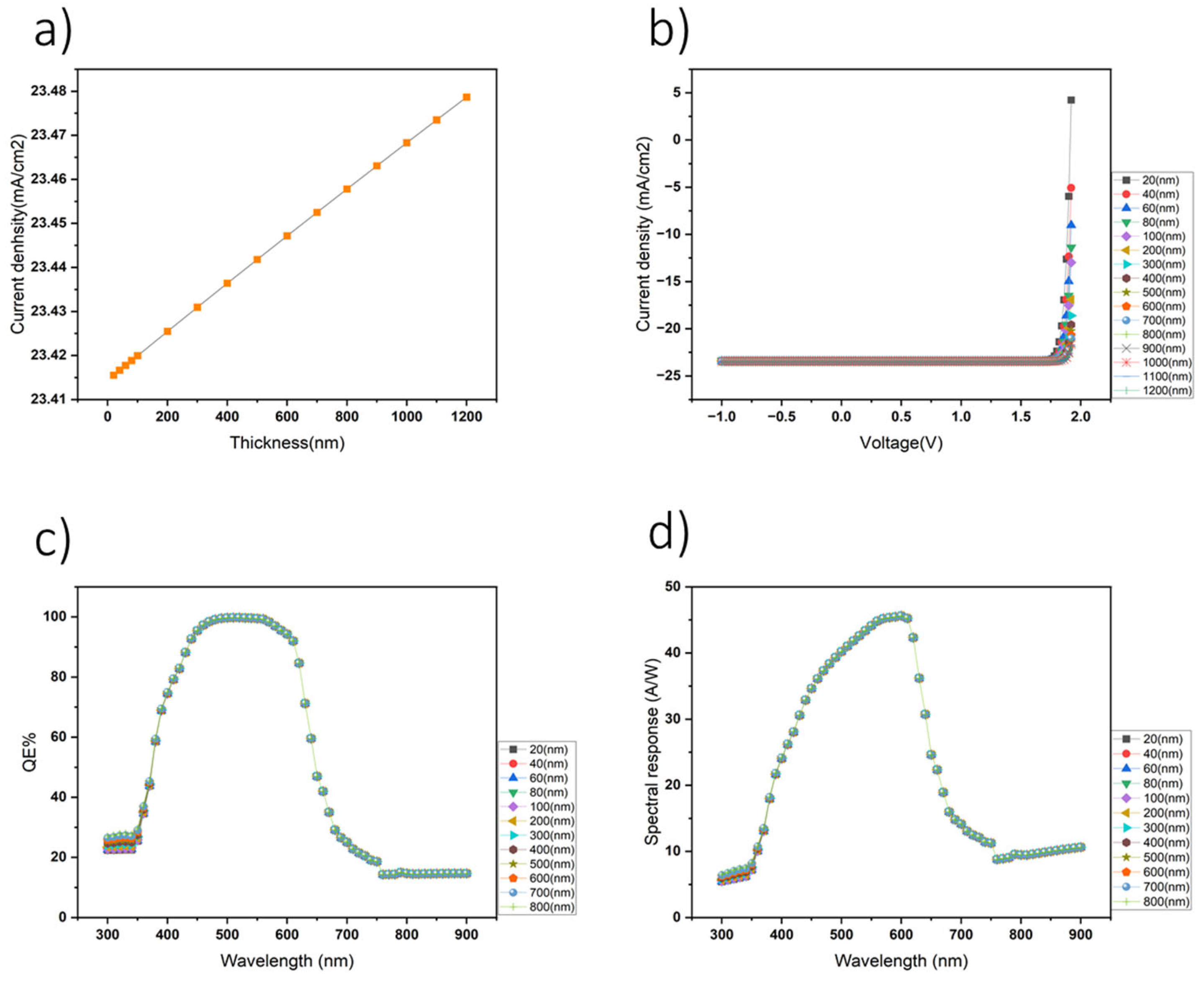
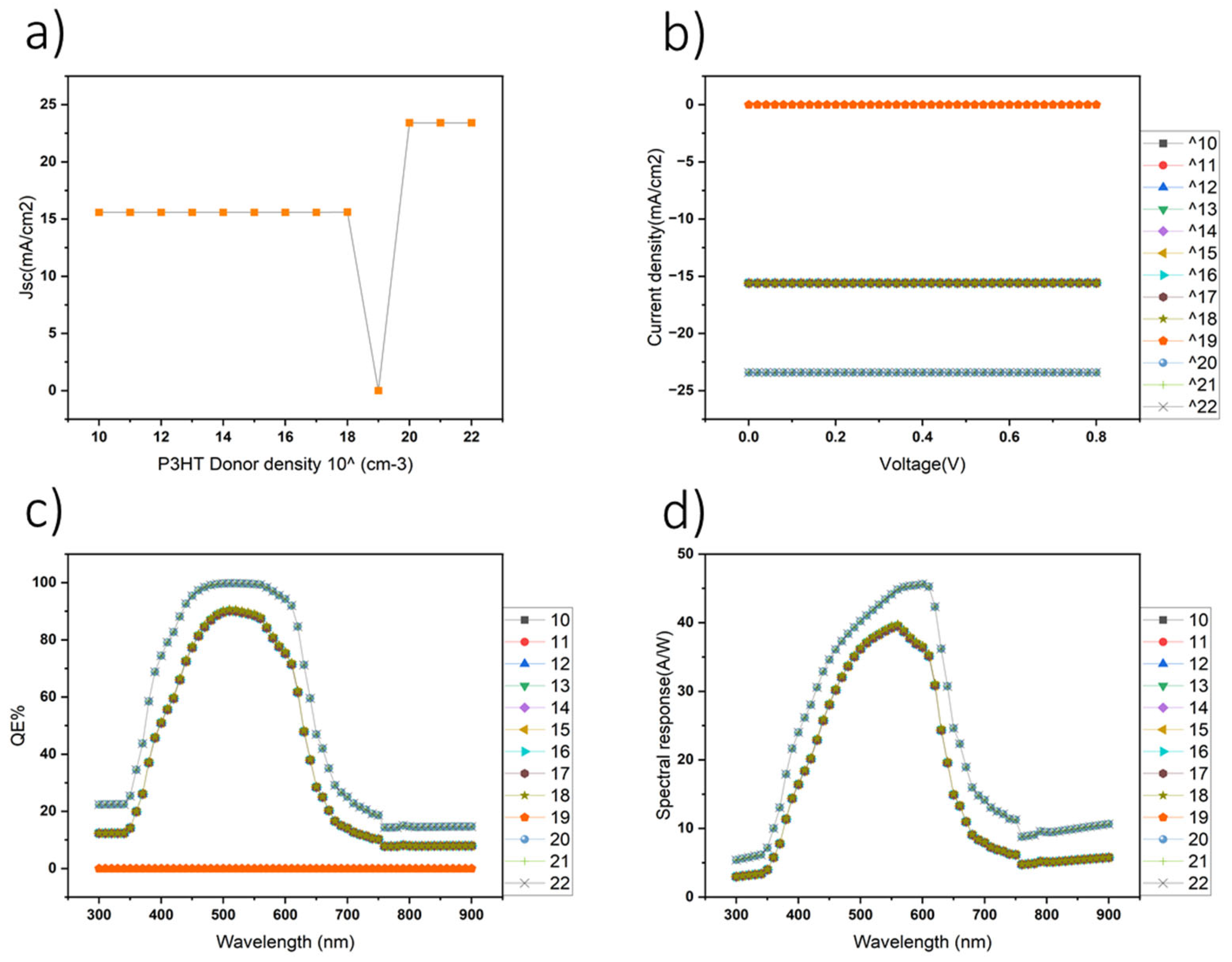


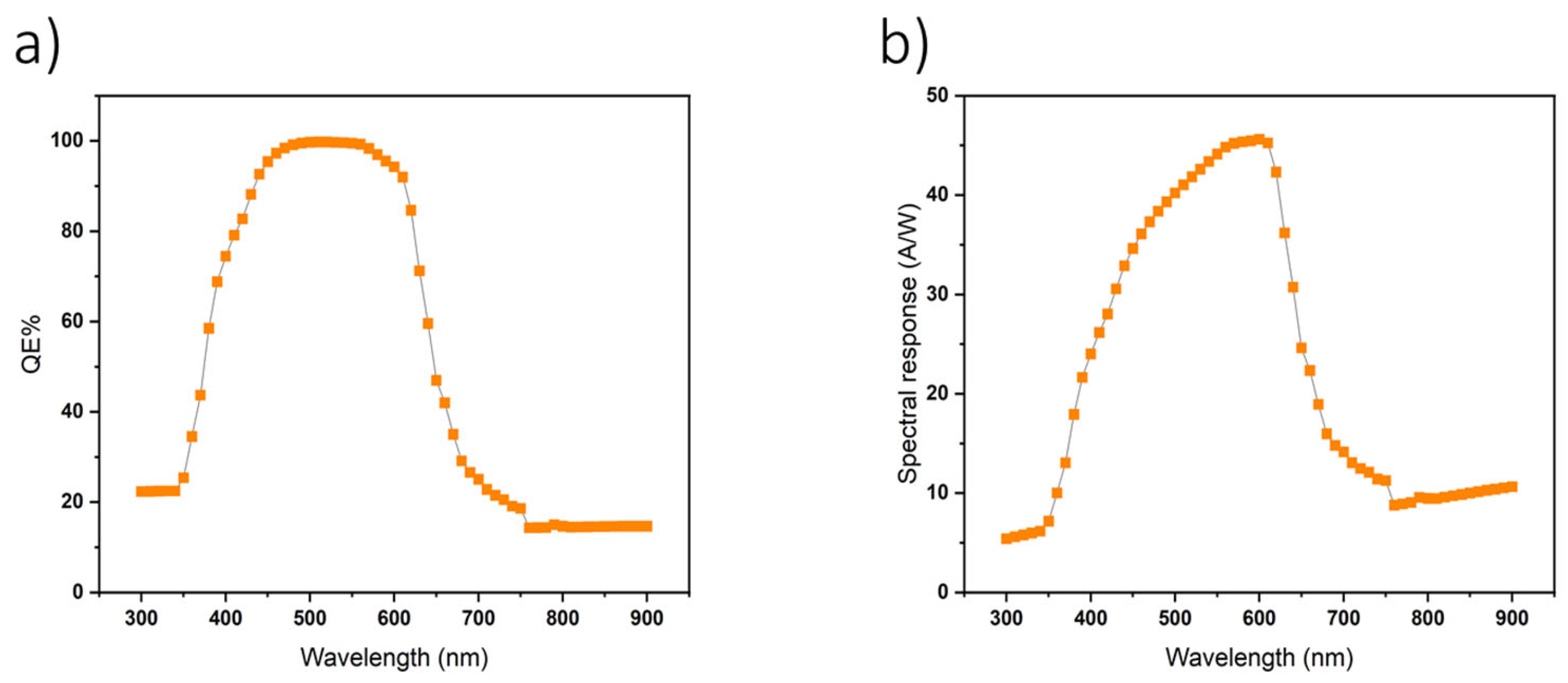
| Material Properties | FTO [27] | P3HT [28,29] | PCBM [30] |
|---|---|---|---|
| Thickness (nm) | 50.00 | 350.00 | 80.00 |
| Band gap (eV) | 3.500 | 2.100 | 2.100 |
| Electron affinity (eV) | 4.000 | 3.500 | 3.900 |
| Dielectric permittivity | 9.000 | 4.400 | 3.900 |
| Conduction band effective density of states, nc (cm−3) | 2.20 × 1018 | 1.00 × 1018 | 2.20 × 1019 |
| Conduction band effective density of states, nv (cm−3) | 1.80 × 1019 | 1.00 × 1018 | 2.20 × 1019 |
| Electron thermal velocity, Ve (cm/s) | 1.00 × 107 | 1.00 × 107 | 1.00 × 107 |
| Hole thermal velocity, Vh (cm/s) | 1.00 × 107 | 1.00 × 107 | 1.00 × 107 |
| Electron mobility, µe (cm2/Vs) | 2.00 × 101 | 8.00 × 10−4 | 0.001 |
| Hole mobility, µh (cm2/Vs) | 1.00 × 107 | 8.00 × 10−4 | 0.002 |
| Shallow uniform donor density, nD (cm−3) | 2.00 × 1021 | 2.00 × 1020 | 1.00 × 1016 |
| Shallow uniform acceptor density, nA (cm−3) | 1.00 × 1020 | 1.00 × 1019 | 1.00 × 1019 |
| Defect density | 1.00 × 1015 | 1.00 × 1015 | 1.00 × 1018 |
Disclaimer/Publisher’s Note: The statements, opinions and data contained in all publications are solely those of the individual author(s) and contributor(s) and not of MDPI and/or the editor(s). MDPI and/or the editor(s) disclaim responsibility for any injury to people or property resulting from any ideas, methods, instructions or products referred to in the content. |
© 2024 by the authors. Licensee MDPI, Basel, Switzerland. This article is an open access article distributed under the terms and conditions of the Creative Commons Attribution (CC BY) license (https://creativecommons.org/licenses/by/4.0/).
Share and Cite
Alali, A.S.; Oduncuoglu, M.; Touati, F. Optimizing P3HT/PCBM-Based Organic Photodetector Performance: Insights from SCAPS 1D Simulation Studies. Nanomaterials 2024, 14, 1146. https://doi.org/10.3390/nano14131146
Alali AS, Oduncuoglu M, Touati F. Optimizing P3HT/PCBM-Based Organic Photodetector Performance: Insights from SCAPS 1D Simulation Studies. Nanomaterials. 2024; 14(13):1146. https://doi.org/10.3390/nano14131146
Chicago/Turabian StyleAlali, Ahmet Sait, Murat Oduncuoglu, and Farid Touati. 2024. "Optimizing P3HT/PCBM-Based Organic Photodetector Performance: Insights from SCAPS 1D Simulation Studies" Nanomaterials 14, no. 13: 1146. https://doi.org/10.3390/nano14131146
APA StyleAlali, A. S., Oduncuoglu, M., & Touati, F. (2024). Optimizing P3HT/PCBM-Based Organic Photodetector Performance: Insights from SCAPS 1D Simulation Studies. Nanomaterials, 14(13), 1146. https://doi.org/10.3390/nano14131146






